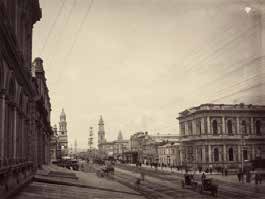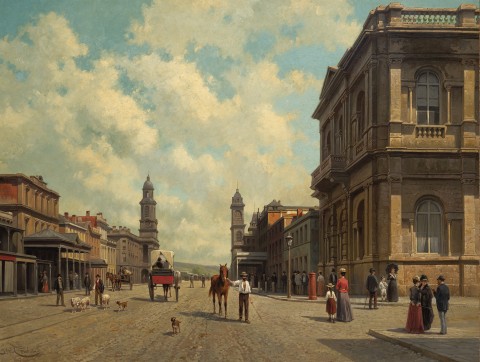KING WILLIAM ST, ADELAIDE, 1907
JACQUES CARABAIN
oil on canvas
95.0 x 125.0 cm
signed and dated lower left: Jacqs - Carabain / 1907
signed and inscribed on artist’s label verso: The Main Road a Adelaide Western Australia/ original / Jacques / Carabain
probably: sold at auction, Antwerp, May 1968 (as ‘View of Adelaide’)
Private collection
Christie's, London, 18 March 1969, lot 113 (as 'Looking South along King William Street, Adelaide')
Corporate collection, Melbourne
Corporate collection, Sydney
Fish, P., ‘Wild scenes at glimpse of what's on offer’, Sydney Morning Herald, Sydney, 23 August 2008, p. 64 (illus.)
1 UNSURE.jpg

Described as the ‘Canaletto of colonial thoroughfares’, Jacques François Carabain is one of the cohort of European artists who spent time in ‘Marvellous Melbourne’ in the later nineteenth century.1 Born and trained in Amsterdam, he travelled widely throughout Europe, honing his ability as a painter of brightly lit, romantic-realistic views of cityscapes and historic buildings. In 1880 he became a Belgian citizen. Carabain’s biography in Australia is less clear, with his earliest known painting of an Australian landscape – of the river port of the Yarra – dated 1879 (ANZ Collection). However there is no other evidence that he had arrived by that date – indeed newspaper articles of 1885 describe Carabain as a recent arrival, setting up a studio in Collins Street east (the artists’ end) and exhibiting with the Victorian Academy of Arts in March of that year.2 Although offering portraiture ‘as the most immediately remunerative’ art form, landscapes were clearly his passion, and a local reviewer praised them as ‘notable for a certain sunny quality, for the accuracy of their local colour, and for the realism of their treatment.’3
This view of Adelaide is one of a number of impressive antipodean streetscapes by Carabain: of Collins and of Swanston streets in Melbourne (State Library of Victoria); King and George streets in Sydney (National Library of Australia); and of Queen Street in Auckland, a highlight painting in the collection of the Auckland Art Gallery Toi o Tāmaki. In this Adelaide view, Carabain shows King William Street from the corner of Currie Street, looking north to the belltowers of the Adelaide Town Hall (left) and the General Post Office (right). The imposing edifice that dominates the scene is the Bank of Adelaide, built in 1880 – 01 with dramatic two-tone stonework, not apparent in this rendition. While the painting is dated 1907, it is evident that Carabain based his view upon an earlier photograph, a practice he is known to have employed.4 The small two-storey building beside the bank, for example, was replaced in 1898 with the ornate National Mutual Life Association building that remains today.5 Noticeably, when compared with photographs from the 1880s and ‘90s, Carabain has made the aesthetic decision to omit the large, insulator-laden telegraph poles that marched along the major roads, and their multitude of taut wires that bisected the sky (conversely, he did include them in his views of Collins and Queen streets).6 Tom Roberts made a similar excision, avoiding the wires in his famous impressionist painting, Allegro con brio, Bourke St West c.1885 – 86 (National Gallery of Australia). Carabain also only hints at the horse-drawn trams that ran along King William Street. By doing so, he conveys a calm, prosperous and orderly city, its occupants enjoying the morning sun.
1. Roger Blackley, The Guide, Auckland Art Gallery Toi o Tāmaki, 2001, see:
www.aucklandartgallery.com/explore-art-and-ideas/artwork/6706/queen-stre...
2. ‘The Victorian Academy of Arts’, The Argus, Melbourne, 28 March 1885, p. 13. Similarly, it is not confirmed when he left Australia, with 1889 often cited.
3. ‘Art notes’, The Argus, Melbourne, 27 April 1885, p. 6
4. Queen Street, Auckland was based upon a photograph by George Valentine. It is not confirmed whether Carabain personally visited New Zealand. Similarly, the 1879 painting of the Yarra is likely to have been based on a photograph.
5. While Carabain was typically very accurate, the two buildings painted beside the bank do not correspond to the buildings recorded in photographs.
6. Collins St, Melbourne, 1889, oil on canvas, 125.0 x 95.0 cm, sold Christies, Melbourne, 26 November 1996, lot 144
ALISA BUNBURY
